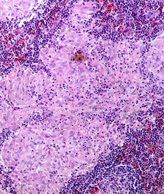Identifying Oropharyngeal Cancer Patients Who Require PEG Tube During Chemo
Researchers have identified several risk factors that may help predict which patients with oropharyngeal cancer may require a percutaneous endoscopic gastrostomy tube during chemoradiotherapy, according to a newly published review.
Sarcoid-like lesion in a nuchal lymph node in a case of oropharyngeal squamous cell carcinoma; source: Patho, Wikimedia Commons

Researchers have identified several risk factors that may help predict which patients with oropharyngeal cancer may require a percutaneous endoscopic gastrostomy tube during chemoradiotherapy, according to a single institution review published in JAMA Otolaryngology – Head & Neck Surgery.
“Many centers place prophylactic PEG tubes in all patients treated with radiochemotherapy for oropharyngeal cancers,” said study author Jimmy J. Caudell, MD, PhD, of the department of radiation oncology at Moffitt Cancer Center. “These results show that we can possibly reduce the need for PEG tube placement in patients with locally advanced oropharyngeal cancer treated with radiochemotherapy.”
According to background information in the article, the placement of prophylactic PEG tube carries many risks including “an infection rate of 5% to 8%, along with diarrhea, constipation, electrolyte abnormalities, gastrointestinal bleeding, a clogged lumen and tube replacement, and metastatic seeding at the gastrostomy site.”
Caudell and colleagues sought to identify risk factors that lead to the reactive placement of a PEG tube in order to potentially reduce their use in patients without a need. To do that, they conducted a review of 297 patients treated with intensity-modulated radiation therapy and concurrent chemotherapy. Patients had oropharyngeal squamous cell carcinoma and were treated between May 2004 and June 2012. The minimum follow-up was 3 months.
Of the 297 patients, 128 (43.1%) did not receive a prophylactic PEG tube within 10 days of initiation of treatment. However, 15 of those patients (11.7%) later required reactive placement of a PEG tube. Among these patients, the median time to PEF tube placement was 35 days.
The researchers were able to identify several independent risk factors leading to the placement of a PEG tube. Among the most highly predictive were a cumulative cisplatin dose of 200 mg/m2 (OR = 6.7; 95% CI, 1.2-36.7; P = .03) and a body mass index of less than 25 (OR = 5.8; 95% CI, 1.4-23.9; P = .02). The researchers also found that those patients who were assigned an accelerated irradiation fractionation (OR = 4.3; 95% CI, 1.1-16.5; P = .04) and those with a tumor T classification of 3 or higher (OR = 3.5; 95% CI, 1.0-11.9; P = .04) were at increased risk for reactive placement.
Overall, patients at the highest risk for reactive placement of a PEG tube were those on an accelerated radiation therapy schedule (27.8% crude rate) and those who received a conventional radiation therapy schedule and had a BMI of less than 25 (23.8% crude rate).
The researchers pointed out that their study is limited by the relatively long study period and the low rate of reactive PEG tube placement.